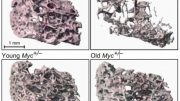
Mayo Clinic biologists discovered that senescent cells, which accumulate with age, negatively impact health and reduce lifespan in mice. Removing these cells delays tumor formation, preserves organ function, and extends lifespan without adverse effects.
A team of biologists from the Mayo Clinic have shown that senescent cells – cells that no longer divide and accumulate with age – negatively impact health and shorten lifespan by as much as 35 percent in normal mice. The results, which appear today in Nature, demonstrate that clearance of senescent cells delays tumor formation, preserves tissue and organ function, and extends lifespan without observed adverse effects.
“Cellular senescence is a biological mechanism that functions as an ‘emergency brake’ used by damaged cells to stop dividing,” says Jan van Deursen, Ph.D., Chair of Biochemistry and Molecular Biology at Mayo Clinic, and senior author of the paper. “While halting cell division of these cells is important for cancer prevention, it has been theorized that once the ‘emergency brake’ has been pulled, these cells are no longer necessary.”
The immune system sweeps out the senescent cells on a regular basis, but over time becomes less effective. Senescent cells produce factors that damage adjacent cells and cause chronic inflammation, which is closely associated with frailty and age-related diseases.
Mayo Clinic researchers used a transgene that allowed for the drug-induced elimination of senescent cells from normal mice. Upon administration of a compound called AP20187, the removal of senescent cells delayed the formation of tumors and reduced the age-related deterioration of several organs. The median lifespan of treated mice was extended by 17 to 35 percent. They also demonstrated a healthier appearance and a reduced amount of inflammation in fat, muscle, and kidney tissue.
“Senescent cells that accumulate with aging are largely bad, do bad things to your organs and tissues, and therefore shorten your life but also the healthy phase of your life,” says Dr. van Deursen. “And since you can eliminate the cells without negative side effects, it seems like therapies that will mimic our findings – or our genetic model that we used to eliminate the cells – that drugs or other compounds that can eliminate senescent cells would be useful for therapies against age-related disabilities or diseases or conditions.”
Darren Baker, Ph.D., a molecular biologist at Mayo Clinic, and first author on the study is also optimistic about the potential implications of the study for humans.
“The advantage of targeting senescent cells is that clearance of just 60 to 70 percent can have significant therapeutic effects,” says Dr. Baker. “If translatable, because senescent cells do not proliferate rapidly, a drug could efficiently and quickly eliminate enough of them to have profound impacts on healthspan and lifespan.”
The research was supported by the National Institutes of Health, the Paul F. Glenn Foundation, the Ellison Medical Foundation, the Noaber Foundation, and the Mayo Clinic Robert and Arlene Kogod Center on Aging.
Others on the research team include: Bennett Childs; Matej Durik, Ph.D.; Melinde Wijers, Jian Zhong, Ph.D., Rachel Saltness, Grace Verzosa, M.D., Abdulmohammad Pezeshki, Ph.D., Khashayarsha Khazaie, Ph.D., Jordan D. Miller, Ph.D.; all of Mayo Clinic.
Dr. van Deursen is a co-inventor of the technology that has been licensed by Mayo Clinic to Unity Biotechnology. Mayo Clinic and Dr. Van Deursen have a financial interest in the technology referenced in this news release.
Reference: “Naturally occurring p16Ink4a-positive cells shorten healthy lifespan” by Darren J. Baker, Bennett G. Childs, Matej Durik, Melinde E. Wijers, Cynthia J. Sieben, Jian Zhong, Rachel A. Saltness, Karthik B. Jeganathan, Grace Casaclang Verzosa, Abdulmohammad Pezeshki, Khashayarsha Khazaie, Jordan D. Miller and Jan M. van Deursen, 3 February 2016, Nature.
DOI: 10.1038/nature16932









clearance of senescent cells up to 60 to 70 percent is what is called for in this article. But the biggest risk is cancer producing cells which do not die may proliferate, even if a controlled mechanism of tampering the cell death is attempted. Birth, living and death are the three fundamentals of ‘physics’ of the nature in biology. If birth is tampered then cell apoptosis will predominate and death will follow soon. If living is prolonged in cells and the cell domination over other living cells will lead to dangerous combinations of tissue formation and existence will be competitive and death will follow. If death is tampered in cells then ‘programmed cell death’ in cells are interrupted and it will only lead to cancerous production of cells.Scientists should never tamper with the nature’s programme. But then they can concentrate on telomeres which is the cap of the chromosomes to last longer a bit to prolong longevity. Environment is the final playing factor on the longevity which can not be controlled by humans. Thank You.